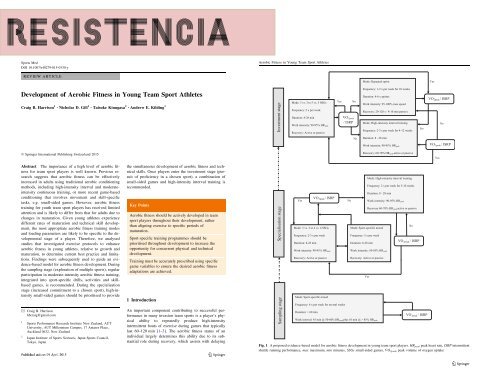Create successful ePaper yourself
Turn your PDF publications into a flip-book with our unique Google optimized e-Paper software.
esistencia<br />
Sports Med<br />
DOI 10.1007/s40279-015-0330-y<br />
Aerobic Fitness in Young Team Sport Athletes<br />
REVIEW ARTICLE<br />
Mode: Repeated sprint<br />
Yes<br />
Development of Aerobic Fitness in Young Team Sport Athletes<br />
Craig B. Harrison 1 • Nicholas D. Gill<br />
1 • Taisuke Kinugasa<br />
2 • Andrew E. Kilding<br />
1<br />
Investment stage<br />
Mode: 3 vs. 3 to 5 vs. 5 SSGs<br />
Frequency: 2 x per week<br />
Duration: 8-28 min<br />
Work intensity: 90-95% HR peak<br />
Recovery: Active or passive<br />
Yes<br />
No<br />
VO2peak<br />
/ ISRP<br />
Frequency: 1-2 x per week for 10 weeks<br />
Duration: 4-6 x sprints<br />
Work intensity: 95-100% max speed<br />
Recovery: 20-120 s / 4-10 min passive<br />
Mode: High-intensity interval training<br />
Frequency: 2-3 x per week for 4-12 weeks<br />
No<br />
VO2peak/ ISRP<br />
No<br />
No<br />
Duration: 8 - 28 min<br />
Work intensity: 90-95% HR peak<br />
VO2peak/ ISRP<br />
Ó Springer International Publishing Switzerland 2015<br />
Recovery: 60-70% HRpeak active or passive<br />
Yes<br />
Abstract The importance of a high level of aerobic fitness<br />
for team sport players is well known. Previous research<br />
suggests that aerobic fitness can be effectively<br />
increased in adults using traditional aerobic conditioning<br />
methods, including high-intensity interval and moderateintensity<br />
continuous training, or more recent game-based<br />
conditioning that involves movement and skill-specific<br />
tasks, e.g. small-sided games. However, aerobic fitness<br />
training for youth team sport players has received limited<br />
attention and is likely to differ from that for adults due to<br />
changes in maturation. Given young athletes experience<br />
different rates of maturation and technical skill development,<br />
the most appropriate aerobic fitness training modes<br />
and loading parameters are likely to be specific to the developmental<br />
stage of a player. Therefore, we analysed<br />
studies that investigated exercise protocols to enhance<br />
aerobic fitness in young athletes, relative to growth and<br />
maturation, to determine current best practice and limitations.<br />
Findings were subsequently used to guide an evidence-based<br />
model for aerobic fitness development. During<br />
the sampling stage (exploration of multiple sports), regular<br />
participation in moderate-intensity aerobic fitness training,<br />
integrated into sport-specific drills, activities and skillbased<br />
games, is recommended. During the specialisation<br />
stage (increased commitment to a chosen sport), high-intensity<br />
small-sided games should be prioritised to provide<br />
& Craig B. Harrison<br />
hbcraig@gmail.com<br />
1<br />
2<br />
Sports Performance Research Institute New Zealand, AUT<br />
University, AUT Millennium Campus, 17 Antares Place,<br />
Auckland 0632, New Zealand<br />
Japan Institute of Sports Sciences, Japan Sports Council,<br />
Tokyo, Japan<br />
the simultaneous development of aerobic fitness and technical<br />
skills. Once players enter the investment stage (pursuit<br />
of proficiency in a chosen sport), a combination of<br />
small-sided games and high-intensity interval training is<br />
recommended.<br />
Key Points<br />
Aerobic fitness should be actively developed in team<br />
sport players throughout their development, rather<br />
than aligning exercise to specific periods of<br />
maturation.<br />
Sport-specific training programmes should be<br />
prioritised throughout development to increase the<br />
opportunity for concurrent physical and technical<br />
development.<br />
Training must be accurately prescribed using specific<br />
game variables to ensure the desired aerobic fitness<br />
adaptations are achieved.<br />
1 Introduction<br />
An important component contributing to successful performance<br />
in many invasion team sports is a player’s physical<br />
ability to repeatedly produce high-intensity<br />
intermittent bouts of exercise during games that typically<br />
last 60–120 min [1–3]. The aerobic fitness status of an<br />
individual largely determines this ability due to its substantial<br />
role during recovery, which assists with delaying<br />
123<br />
Specialisation stage<br />
Sampling stage<br />
Yes<br />
Mode: 3 vs. 3 or 4 vs. 4 SSGs<br />
Frequency: 2-3 x per week<br />
Duration: 8-28 min<br />
Work intensity: 90-95% HR peak<br />
Recovery: Active or passive<br />
Mode: Sport-specific mixed<br />
Frequency: 6 x per week for several weeks<br />
Duration: > 60 min<br />
VO2peak/ ISRP<br />
No<br />
Mode: Sport-specific mixed<br />
Frequency: 5 x per week<br />
Duration: 8-28 min<br />
Work intensity: 50-85% HR peak<br />
Recovery: Active or passive<br />
Yes<br />
Work interval: 45 min @ 50-60% HRpeak plus 10 min @ > 85% HRpeak<br />
Mode: High-intensity interval training<br />
Frequency: 2 x per week for 5-10 weeks<br />
Duration: 8 - 28 min<br />
Work intensity: 90-95% HR peak<br />
Recovery 60-70% HRpeak active or passive<br />
No<br />
VO2peak / ISRP<br />
VO2peak / ISRP<br />
Fig. 1 A proposed evidence-based model for aerobic fitness development in young team sport players. HR peak peak heart rate, ISRP intermittent<br />
shuttle running performance, max maximum, min minutes, SSGs small-sided games, VO _ 2peak peak volume of oxygen uptake<br />
123



